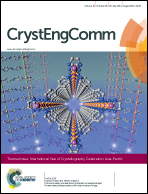Guest dependent dielectric properties of nickel(ii)-based supramolecular networks†
Abstract
Two nickel(II)-based low dielectric supramolecular compounds {[Ni2(bbim)(H2bbim)4]·2CH3COO·CH3CN}2 (1, H2bbim = bisbenzimidazole) and (±)-[Ni(H2bbim)3]·2Cl·2H2O (2) were synthesized and characterized by single-crystal X-ray crystallography. Compound 1 was found to have a dimeric structure with guest molecules such as acetate ions and acetonitrile in its environment, while compound 2 had a monomeric structure with chloride ions and water molecules associated with it. Both compounds were highly thermally stable, especially compound 1, which was stable at temperatures of up to 500 °C. More importantly, compound 1 adopted a sharp different frequency dependent dielectric behaviour when compared with 2. Compound 2 with highly polarizable guest molecules showed a significant higher value of dielectric constant (εr′(ω) = 12.6 at 40 Hz) than that of 1 (εr′(ω) = 4.76 at 40 Hz), indicating that solvent molecules and counterions play a crucial role in regulating the value of the dielectric constant. This study serves as a good example of the design of both high and low-κ materials with a judicious selection of guest molecules in the supramolecular networks.

- This article is part of the themed collection: International Year of Crystallography Celebration: Asia-Pacific

 Please wait while we load your content...
Please wait while we load your content...